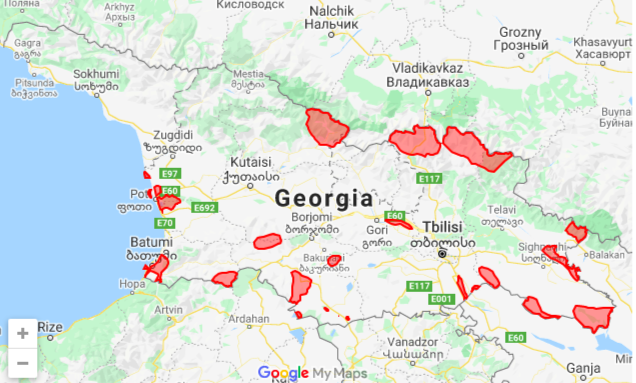Taxonomy
Kingdom Animalia (16266)Phylum Chordata (708)
Class Aves (404)
Order Ciconiiformes (2)
Family Ciconiidae (2)
Genus Ciconia (2)
Species Ciconia nigra
Browse by taxonomy
Simple search by name
Ciconia nigra ✓
Black Stork, შავი ყარყატი (იშხვარი)
Name According To: http://datazone.birdlife.org/species/taxonomy
Species: nigra
Taxon Rank: Species
Scientific Name Authorship: (Linnaeus, 1758)
Vernacular Name: Black Stork
Georgian Name: შავი ყარყატი (იშხვარი)
GBD Remarks:
Conservation Status (International): IUCN status (international) Least Concern, ver 3.1. Definition (This species has an extremely large range; population is not believed to be decreasing sufficiently rapidly to approach the thresholds under the population trend criterion (>30% decline over ten years or three generations). The global population is estimated to number c.24,000-44,000 individuals (Wetlands International 2006).
Conservation Status (national): Georgian Red List (2006) VU (D1): (Small population; Population size estimated to number fewer than the total number of known breeding pairs ranged between 12 and 17 mature individuals).
Economic importance (national): Currently absent. Potentially interesting for attracting birdwatchers.
Monitoring methods: Nest census.
Ongoing research: absent
Specific relevant information:
Rare summer migratory breeder and passage visitor to Georgia. In Georgia, species is found in eastern part of the country: flood-lands of Kura (Mtkvari) River (3-4 pairs), Alazani River (5-6), Iori River(2-3) and Khrami River(1-2); slopes of Trialethi Ridge in central part (3-4); some ridges of Great Caucasus(5); Rioni River (2-3); During last decade the total number of known breeding pairs ranged between 12 and 17.
This bird in Georgia nests in two types of habitats: in the riverine forest, nest are located on poplars, 10-18 m height; otherwise, on rocks. Black storks nesting on trees are more circumspect than those nesting on rocks.
The main factor limiting number and distribution in Georgia is the destruction of nesting habitats, primarily through a reduction of floodland forests. Another important threat is the creation of reservoirs, occasional illegal shooting and human disturbance, recreational pressure at nesting locations, overgrazing, and probably pesticides. Two accidental causes of mortality (collapsing with aerial electric conductors and electrocution) have also been registered.
Relevant website: http://www.iucnredlist.org/details/106003830/0
Why to monitor: Species rare and important for conservation. On the other hand, this is a very rare species, whose nests are very sensitive to disturbance, and non-professional monitoring can cause abandoning the nests.
Preliminary suggestion: rely on the occasional records in future and to implement a system of monitoring for discovered nests based on these records.
კონსერვაციული სტატუსი (საერთაშორისო): ნაკლებად მოწყვლადი (Least Concern). განმარტება: სახეობას აქვს დიდი არეალი; არაა სავარაუდო რომ გლობალური პოპულაცია დაეცეს 30%-ზე მეტად ყახლოეს 10 წელიწადში; გლობალური პოპულაციის მიახლოვებითი სიდიდეა 24,000-44,000 ზრდასრული ინდივიდი (Wetlands International 2006).
კონსერვაციული სტატუსი (ეროვნული): საქართველოს წიტელი ნუსხა (2006) VU (D1); მცირე პოპულაცია; ეროვნული პოპულაციის ზომა ფასდება როგორც 12-17 ზრდასრული რეპროდუქციული ინდივიდი.
ეკონომიკური მნიშვნელობა (ეროვნული): სადღეისოდ ნაკლებად მნიშვნელოვანი სახეობა. პოტენციალურად საინტერესო ტურისტებისათვის.
მონიტორინგის მეთოდები: ბუდეების თვლა
მიმდინარე კვლევები საქართველოში: არ მიმდინარეობს
სპეციფიკური ინფორმაცია: იშვიათი საზაფხულო მიგრანტი და ვიზიტორი სახეობა საქართველოში. ბუდობს აღმოსავლეთ საქართველოში: მტკვრის ჭალის ტყე (3-4 წყვილი), ალაზნის ჭალა (5-6 წყვილი), ივრის წალა (2-3 წყვილი), ხრამი (1-2 წყვილი); თრიალეთის ქედის ცენტრალური ნაწილი (3-4), კავკასიონი (5), რიონი (2-3). ბოლო ათწლეულის განმავლობაში დაკავებული ბუდეების რაოდენობა იცვლებოდა 12-17 ფარგლებში.
ბუდობს ორი ტიპის ჰაბიტატში: წალის ტყეში, სადაც ბუდეები განლაგებულია ვერხვებზე, 10-18 მ სიმაღლეზე, ასევე კლდეებზე. ხეებზე მობუდარი წყვილები განსაკუთრებით მოწყვლადებია დაფრთხობის მიმართ.
მთავარი შემცირების მიზეზია საბუდარი ჰაბიტატების განადგურება, პირველ რიგში ჭალის ტყეებში. სხვა მიზეზებია წყალსაცავების შენება, შეწუხება და სროლა, ჭარბი ძოვება და, შესაძლოა, პესტიციდები. ცნობილია ორი დაღუპვის შემთხვევა მაღალი ძაბვის ხაზებთან შეტაკებისას.
ვებსაიტი: http://www.iucnredlist.org/details/106003830/0
რატომაა საჭირო მონიტორინგი: იშვიათი სახეობაა. ამავდროულად ძალიან იშვიათია საქართველოში და არაპროფესიული მონიტორინგის შედეგად არაა გამორიცხული ბუდეების მიტოვება.
წინადადება: შემთხვევითი პოვნების შეტანა მონაცემთა ბაზაში და ცნობილი საბუდრების შემდგომი მონიტორინგი.
Page Authors: Kandaurov A. , Gavashelishvili A, Javakhishvili Z
Reference of occurrence in Georgia:
Information from GBIF about Ciconia nigra
GBIF scientific name: Ciconia nigra (Linnaeus, 1758)
GBIF taxonomic status: ACCEPTED

Conservation Status
This section is under construction
National Red List Status: NT
IUCN Red List Status: LC
Protection status: Not defined
Reason: D1
Trend: Declining
Native/Introduced: Native
Comment: შავი ყარყატი ფართოდაა გავრცელებული და არაა მოწყვლადი საქართველოს ფარგლებს გარეთ. საქართველოში შავი ყარყატის მობუდარი პოპულაცია სტაბილურია, თუმცა მისი მცირერიცხოვნობის გამო ექსპერტთა გადაწყვეტილებით ტაქსონს მიენიჭა საფრთხესთან ახლოს მყოფი სტატუსი NT.
Georgian Name: შავი ყარყატი (იშხვარი)
English Name: Black Stork
Taxonomy according to: http://datazone.birdlife.org/species/taxonomy
References: BirdLife International. 2017. Ciconia nigra (amended version of 2016 assessment). The IUCN Red List of Threatened Species 2017: e.T22697669A111747857. https://dx.doi.org/10.2305/IUCN.UK.2017-1.RLTS.T22697669A111747857.en. Downloaded on 23 April 2021./Kell
Evaluated By: Paposhvili N, Javakhishvili Z, Gavashelishvili A, Abuladze A, Javakhishvili N, Dekanoidze D, Ninua L, Mamuchadze J, Shoshitashvili D, Kandaurov A.
Date evaluated: Nov 2021




